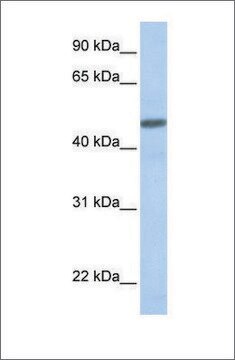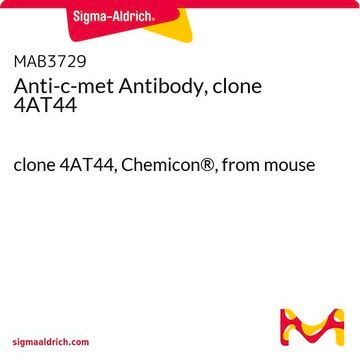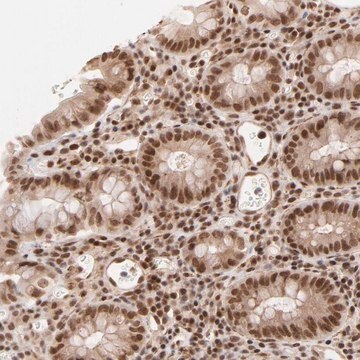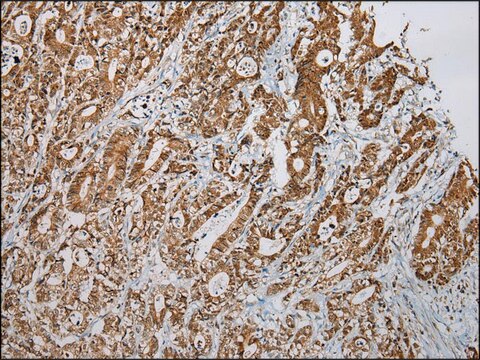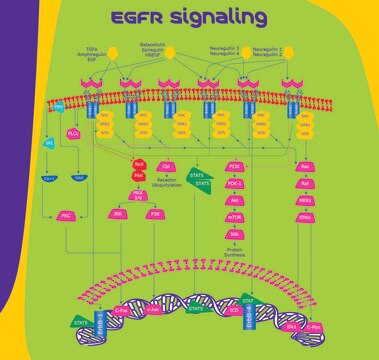MABS1916
Anti-c-Met Antibody, clone seeMet 13
clone seeMet 13, from mouse
Synonym(e):
Hepatocyte growth factor receptor, HGF receptor, HGF/SF receptor, Proto-oncogene c-Met, Scatter factor receptor, SF receptor, Tyrosine-protein kinase Met
About This Item
Empfohlene Produkte
Biologische Quelle
mouse
Qualitätsniveau
Antikörperform
purified immunoglobulin
Antikörper-Produkttyp
primary antibodies
Klon
seeMet 13, monoclonal
Speziesreaktivität
human
Methode(n)
flow cytometry: suitable
immunocytochemistry: suitable
immunoprecipitation (IP): suitable
inhibition assay: suitable
Isotyp
IgG1κ
NCBI-Hinterlegungsnummer
UniProt-Hinterlegungsnummer
Versandbedingung
ambient
Posttranslationale Modifikation Target
unmodified
Angaben zum Gen
human ... HGF(3082)
Verwandte Kategorien
Allgemeine Beschreibung
Spezifität
Immunogen
Anwendung
Zelluläre Signaltransduktion
Flow Cytometry Analysis: A representative lot immunostained live SNU-5 cells. A slight decrease in antibody immunoreactivity was observed when the temperature was dropped from 37°C to 4°C (Wong, J.S., et al. (2013). Oncotarget. 4(7):1019-1036).
Immunocytochemistry Analysis: A representative lot immunostained live SNU-5 cells. Indirect fluorescence labelling following subsequent cell fixation and permeabilization revealed increased antibody cytoplasmic internalization when antibody incubation was performed at 37°C than at 4°C (Wong, J.S., et al. (2013). Oncotarget. 4(7):1019-1036).
Immunoprecipitation Analysis: A representative lot immunoprecipitated c-Met from SNU-5 cell lysate (Wong, J.S., et al. (2013). Oncotarget. 4(7):1019-1036).
Inhibition Analysis: A representative lot prevented HGF-induced scatter of HaCaT cells. Clone seeMet 13 inhibited cell proliferation by blocking cell division without inducing apoptosis (Wong, J.S., et al. (2013). Oncotarget. 4(7):1019-1036).
Note: seeMet 13 exhibited low reactivity and specificity towards denatured c-Met by Western blotting. This monoclonal antibody is not recommended for Western blotting application (Wong, J.S., et al. (2013). Oncotarget. 4(7):1019-1036).
Qualität
Immunocytochemistry Analysis: A 1:500 dilution of this antibody detected both surface and internalized c-Met by fluorescent immunocytochemistry staining of 4% paraformaldehyde-fixed, 0.3% Triton X-100-permeabilized SNU-5 cells.
Zielbeschreibung
Physikalische Form
Lagerung und Haltbarkeit
Handling Recommendations: Upon receipt and prior to removing the cap, centrifuge the vial and gently mix the solution. Aliquot into microcentrifuge tubes and store at -20°C. Avoid repeated freeze/thaw cycles, which may damage IgG and affect product performance.
Sonstige Hinweise
Haftungsausschluss
Not finding the right product?
Try our Produkt-Auswahlhilfe.
WGK
WGK 2
Analysenzertifikate (COA)
Suchen Sie nach Analysenzertifikate (COA), indem Sie die Lot-/Chargennummer des Produkts eingeben. Lot- und Chargennummern sind auf dem Produktetikett hinter den Wörtern ‘Lot’ oder ‘Batch’ (Lot oder Charge) zu finden.
Besitzen Sie dieses Produkt bereits?
In der Dokumentenbibliothek finden Sie die Dokumentation zu den Produkten, die Sie kürzlich erworben haben.
Unser Team von Wissenschaftlern verfügt über Erfahrung in allen Forschungsbereichen einschließlich Life Science, Materialwissenschaften, chemischer Synthese, Chromatographie, Analytik und vielen mehr..
Setzen Sie sich mit dem technischen Dienst in Verbindung.
